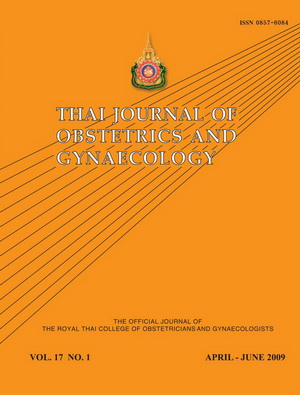A six-hour urinary protein-creatinine ratio for predicting significant proteinuria in preeclampsia
Main Article Content
Abstract
Objective: To determine an optimal cutoff level of urinary protein-creatinine ratio (PCR) obtaining from 6-hour urine collection specimens from women admitted with suspected preeclampsia for investigation of significant proteinuria.
Study design: Diagnostic test.
Subject: Pregnant women admitted for evaluation of preeclampsia were studied prospectively. They were instructed to collect a 24-hour urine in two separate containers: one for first six hours urine specimen, the other for following 18 hours urine specimen. Each sample was measured for volume, protein, and creatinine values. The first 6-hour urinary PCR and total 24-hour proteinuria were calculated. A receiver operating characteristic curve (ROC) of the 6-hour urinary PCR was constructed in order to determine the optimal cutoff level for estimate the degree of proteinuria.
Results: A total of 120 out of 126 women completed the study; 96 (80%) had significant proteinuria. This study had shown moderate correlation between 6-hour urine protein and 24-hour urine protein.By using a 6-hour urinary PCR, the optimal cutoff level to predict significant proteinuria was ≥ 0.20 which yielded sensitivity, specificity, PPV, NPV and area under the ROC curve of 93.7%, 64.0%, 90.8%,72.7% and 0.788 respectively. On the other hand, a cutoff level of ≥ 0.10 had shown a sensitivity of 100% and specificity of 20.8%, while the cutoff level of ≥ 0.75 offered 100% specificity, but poor sensitivity of 55.7%.
Conclusions: The 6-hour urinary PCR at ≥ 0.20 is the most appropriate value for diagnosis of significant proteinuria in preeclampsia.


